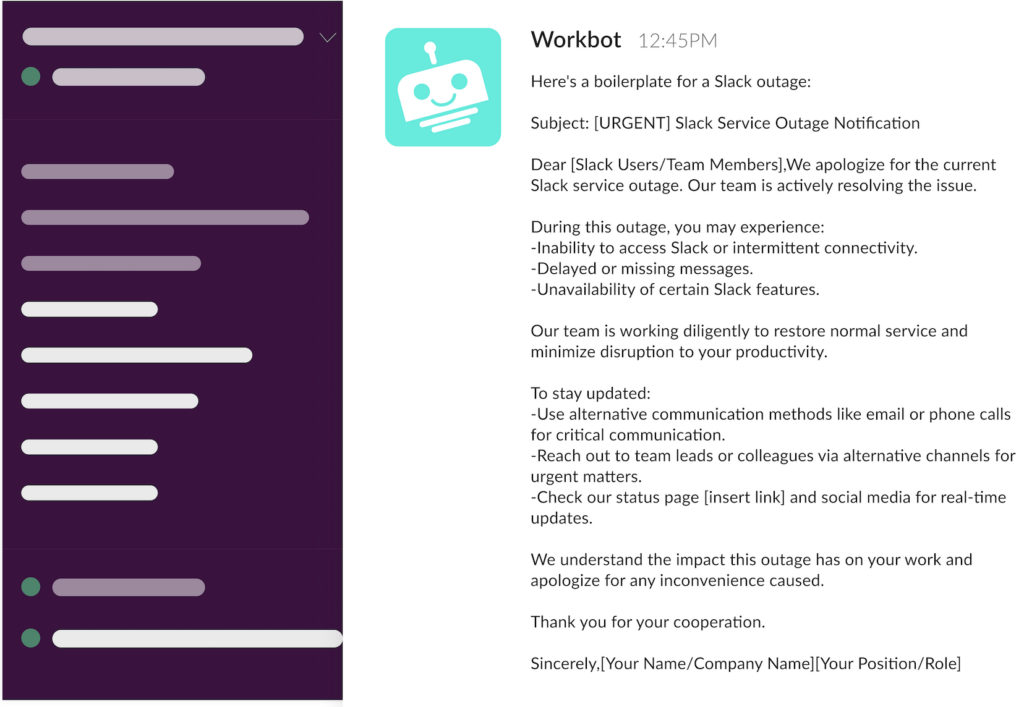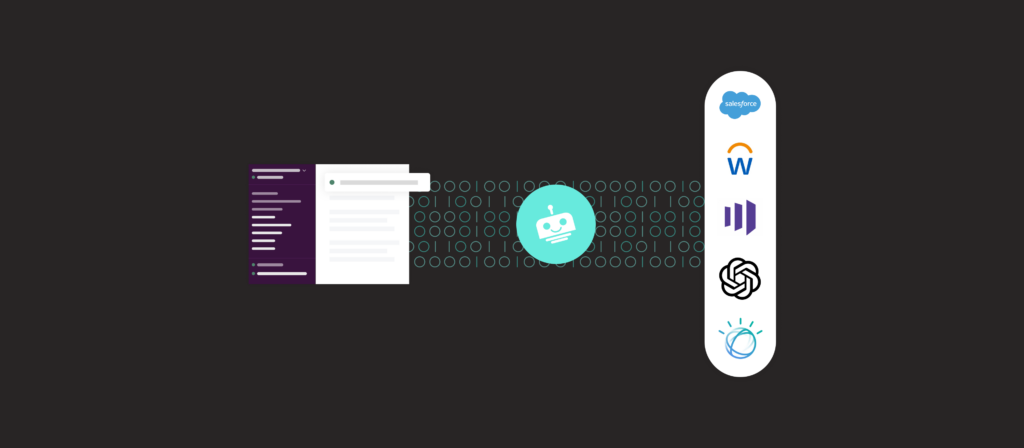As artificial intelligence (AI) advances at a blistering pace, the workflow automations you can build become more and more powerful.
This opportunity presents a few challenges: You’ll need to determine the processes that stand to benefit most from AI-based automations; and you’ll need to implement these workflow automations in ways that leverage AI to full effect.
We’ll help you address both challenges by reviewing a few impactful AI workflow automations. But first, let’s align on what we mean by AI workflow automation.

Ready to harness the power of GPT in your automations?
Workato, the leader in enterprise automation, offers a pre-built connector for OpenAI, allowing your team to easily and quickly build LLM-powered automations.
What is AI workflow automation?
It’s any workflow automation that uses AI. The workflow automation can use AI at a single step, or in multiple steps, and it can use different applications of AI, such as image generation, text generation, text analysis, etc.
As you’ll see in our examples, employees can trigger and interact with AI workflow automations from their business communications platform, such as Slack or Microsoft Teams.
Examples of AI workflow automation
Here are a few impactful use cases:
Enable reps to create personalized and engaging presentations
As sales reps pitch your product to prospects, they’ll want to not only keep your prospects’ attention but also help prospects visualize how they can use your product.
To help your reps accomplish both, you can build a workflow automation that uses an AI system like DALL-E. Here’s how it can work:
1. A sales rep accesses a customized chatbot in your business communications platform.

2. Within the chatbot, they’re able to explain the kind of image they want to create. They can also specify the number of images they want, its resolution, whether they want it in a file or a URL, etc.
3. The chatbot then takes of all the submitted information, and, using an AI model like DALL-E, creates the requested image(s) and shares it directly with the rep in near real-time.
Related: Popular workflow automations
Refine your marketing collateral before pushing it live
Your team likely employs talented writers to create blog posts, whitepapers, 1-pagers, among other content assets.
Their copy is likely already effective and compelling once finished. However, there’s always room for improvement. To help them up-level their work, whether that’s for tone of voice, grammar, clarity, etc., you can build the following workflow automation:
1. A marketer accesses a customized chatbot in your business communications platform.
2. Within the chatbot, they’re able to provide the copy they want edited. They’re also able to provide instructions around how they want the copy improved, the number of edits they’d like, and the degree of predictability they’re looking for in the edits.
3. The chatbot then takes of all the submitted information, and, using an AI model like GPT-4, edits the copy in a way that meets the marketer’s requirements before sharing it with them.
Popular Slack integrations
Empower BT to carry out business-critical tasks quickly
Your business technology (BT) team is likely putting out fires throughout the day while also carrying out important business initiatives, like app migrations.
You can make their lives easier and allow them to allocate more time towards the work they enjoy and that’s important by streamlining the task of crafting copy for company-wide announcements (e.g. a Slack outage).
Here’s a closer look at the workflow automation:
1. A member of BT accesses a customized chatbot in your business communications platform.
2. Within the chatbot, they enter in their prompt (e.g. create a boilerplate for communicating a Slack outage). They also add in the number of answers, or completions, they’d like; the maximum number of tokens (to provide a guardrail on length); a potential stop phrase, such as a period, to also control the length of the response; and the level of predictability they want in the copy.
3. The chatbot takes of all the submitted information, and, using an AI model like GPT-4, creates the boilerplate and shares it with the employee in BT.

Related: A deep dive on AI-powered automations
Benefits of AI workflow automation
Here’s how AI workflow automation can help your organization:
Streamline tedious tasks
Writing from scratch can be time-consuming, difficult, and, for many, unpleasant. The same goes for proofreading your writing.
Using AI workflow automation, you can easily and quickly overcome writer’s block and pinpoint and correct grammatical errors—allowing you to focus less time on these tasks and more on the work you enjoy and are best suited to handle.
Related: The benefits of intelligent automation
Elevate employee performance
Creatives, such as writers and designers, often need a partner to ideate and bounce ideas off of. And while they can try to brainstorm with colleagues, their team members often don’t have time to participate or the expertise needed to serve as effective collaborators.
Fortunately, AI workflow automations can act as effective stand-ins. Designers can use them to quickly mock up different designs to rule out ideas and pursue others further; while writers can gather various iterations of copy quickly for inspiration.
Creatives aren’t the only beneficiaries of AI workflow automations: Sales can put together more personalized and effective presentations; product can create more digestible documentation from release notes; customer support can classify client issues and route them to the right teams automatically—and the list goes on.
Offer employees easy access
Instead of forcing employees to create their own account with an AI platform and learn how to use it (which also introduces security risks for your business), you can bring the AI platform and its capabilities to the place your employees already work from—your business communications platform. Moreover, you can guide your employees into making effective prompts by providing tips and tricks within the chatbot interface, all but ensuring that your employees are able to make the most of the AI.
How to evaluate AI workflow automation solutions
Once you’re bought into implementing AI workflow automations, you’ll need to review and decide on the platform to build them in.
Here are some considerations that can help you identify the best platform for your organization:
Low-code/no-code
As your organization’s needs evolve, you’ll likely need to modify existing automations and build net-new ones. Employees within IT are not only poorly-suited to address these demands quickly over time—they’re also unaware of many AI workflow automations that can benefit specific lines of business.
You can neatly overcome these hurdles by adopting a low-code/no-code platform that business teams can use and that, of course, allows IT to oversee the platform.
Related: How to support citizen integrators
Security
The applications you connect the AI platform to and the data that moves between them often consists of personal identifiable information. And when this is isn’t the case, the data is often sensitive for other reasons (e.g. financial statements).
With this in mind, the integration and automation platform you select should offer enterprise-grade security and governance features, like fine-grained access controls and enterprise key management. In addition, it should offer pre-built connectors for AI solutions that let you easily and securely authenticate to their APIs.
Chatbots
As our examples highlighted, customizable chatbots can be instrumental to your AI workflow automations’ success.
To use them, you’ll need a platform that offers customizable chatbots that can interact between your business communications platform and the rest of the applications you connect to (including AI solutions). It should also be able to take user permissions into account. That way, employees are only able to access the data and actions in their apps that fall within their scope of permissions.

Build AI workflow automations with Workato
Workato, the leader in enterprise automation, offers Workbot®, a customizable platform bot for Slack or Teams, and an OpenAI connector. Taken together, you can build intelligent automations that work from your business comms platform.
